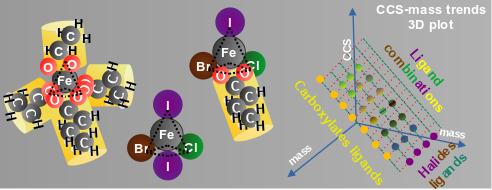"Generalization of the CCS-Mass Equation to Account for Variations in Molecular Density in an Iron-Ligand Complex Growing System"
Christopher Kune, Johann Far, Sophie Rappe, Jean Haler, Albert Demonceau, Lionel Delaude, Gauthier Eppe, and Edwin De Pauw
 |
source: Rapid Communications in Mass Spectrometry
year: 2025
volume: 39
article: e10042
pages: 9
doi: 10.1002/rcm.10042
|

Abstract:
Rationale: In this work, the CCS-mass trends equation has been revisited to consider apparent changes in the ion density.
Methods: The ion mobility-derived collision cross section (IM-derived CCS) of negatively, single charged Fe(II) and Fe(III) metal centers coordinated with three or four halide or linear alkyl carboxylate ligands generated by electrospray operating in the negative ionization mode were obtained using a T-wave mobility cell.
Results: The CCS-mass trends were fitted using the equation CCS = A x massPow (where A is an apparent density parameter and Pow is a shape parameter). Iron-halide complexes led to Pow parameters well below the typical limit of 0.5, which could only be explained by refining the fitting equation using a linear combination of these A and Pow parameters. Their physical meaning is described in terms of mass distribution within the volume of the iron-ligand complex ions.
Conclusions: The analysis of the CCS-mass trend of iron-halide and iron-carboxylate complexes allows to predict the IM-derived CCS and the CCS-mass trends of combinations of iron-halide/carboxylate complexes. The results show no differences in trend between planar trigonal and tetrahedral geometries as described by the valence shell electron pair repulsion (VSEPR) theory.
[Full Text] [<< Previous Article] [Back to the List of Publications] [Next Article >>] l.delaude@ulg.ac.be